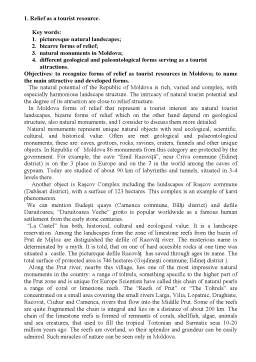Extras din referat
1. Relief as a tourist resource.
Key words:
1. picturesque natural landscapes;
2. bizarre forms of relief;
3. natural monuments in Moldova;
4. different geological and paleontological forms serving as a tourist attractions.
Objectives: to recognize forms of relief as tourist resources in Moldova; to name the main attractive and developed forms.
The natural potential of the Republic of Moldova is rich, varied and complex, with especially harmonious landscape structure. The intricacy of natural tourist potential and the degree of its attraction are close to relief structure.
In Moldova forms of relief that represent a tourist interest are natural tourist landscapes, bizarre forms of relief which on the other hand depend on geological structure, also natural monuments, and I consider to discuss them more detailed:
Natural monuments represent unique natural objects with real ecological, scientific, cultural, and historical value. Often are met geological and palaeontological monuments; these are: caves, grottoes, rocks, ravines, craters, funnels and other unique objects. In Republic of Moldova 86 monuments from this category are protected by the government. For example, the cave “Emil Racoviţă”, near Criva commune (Edineţ district) is on the 3 place in Europe and on the 7 in the world among the caves of gypsum. Today are studied of about 90 km of labyrinths and tunnels, situated in 3-4 levels there.
Another object is Raşcov Complex including the landscapes of Raşcov commune (Dubăsari district), with a surface of 123 hectares. This complex is an example of karst phenomenon.
We can mention Budeşti quays (Camenca commune, Bălţi district) and defile Duruitoarea; “Duruitoarea Veche” grotto is popular worldwide as a famous human settlement from the early stone centuries.
“La Castel” has both, historical, cultural and ecological value. It is a landscape reservation. Among the landscapes from the zone of limestone reefs from the bazin of Prut de Mijloc are distiguished the defile of Racovăţ river. The misterious name is determinated by a myth. It is told, that on one of hard accesible rocks at one time was situated a castle. The pictureque defile Racovăţ has saved through ages its name. The total surface of protected area is 746 hectares (Gojdineşti commune, Edineţ district ).
Along the Prut river, nearby this village, lies one of the most impressive natural monuments in the country: a range of toltrels, something specific to the higher part of the Prut zone and is unique for Europe Scientists have called this chain of natural pearls a range of coral or limestone reefs. The “Reefs of Prut” or “The Toltrels” are concentrated on a small area covering the small rivers Larga, Vilia, Lopatnic, Draghiste, Racovat, Ciuhur and Camenca, rivers that flow into the Middle Prut. Some of the reefs are quite fragmented the chain is integral and lies on a distance of about 200 km. The chain of the limestone reefs is formed of remnants of corals, shellfish, algae, animals and sea creatures, that used to fill the tropical Tortonian and Sarmatic seas 10-20 million years ago. The reefs are overland, so their splendor and grandeur can be easily admired. Such miracles of nature can be seen only in Moldova.
2. Climate as a tourist resource.
The climate of Republic of Moldova in general is mild.
The Republic of Moldova is located in a zone with a temperate continental climate approximately half way between the Equator and North Pole. The four seasons of the year are clearly defined, winter being warm, and summer long, with a lot of sunny days. The general movement of the atmospheric air mass is mostly from the Northwest Atlantic or Southwest.The mean temperature of the air from North to South ranges between +7.5 0C and +10 0C. There are 2060–2360 hours of sunshine per year in Moldova; temperatures above freezing are registered 160–200 days per year; and precipitation ranges between 370 and 560 mm/year and more than 10% falls as snow, which can melt several times during winter.
The winter in Moldova is moderate, with a mean temperature in January of –5 to -3 0C. Some days it can fall to –15 to -20 0C, and during an intrusion of the arctic air mass even to –35 0C. The spring is not stable, as the number of sunny days and the mean air temperature is rising. In May the temperature is around +15 0C, decreasing the risk of late frosts.
The summer is hot and long, with the long periods of drought. The mean temperature in July is +19.5 to +22 0C, but sometimes can reach +35 to +40 0C. The summer rains are in most cases heavy and of short duration, sometimes causing local flooding.
The autumn is warm and long too, a so-called “Indian summer”. In November the mean temperature falls to +5 to +3 0C and may bring the first snowfalls and frosts.
In general the climate of Moldova is mild, and makes possible to travel in the reublic the whole year.
Preview document
Conținut arhivă zip
- Natural Tourist Resources of the Republic of Moldova.doc









